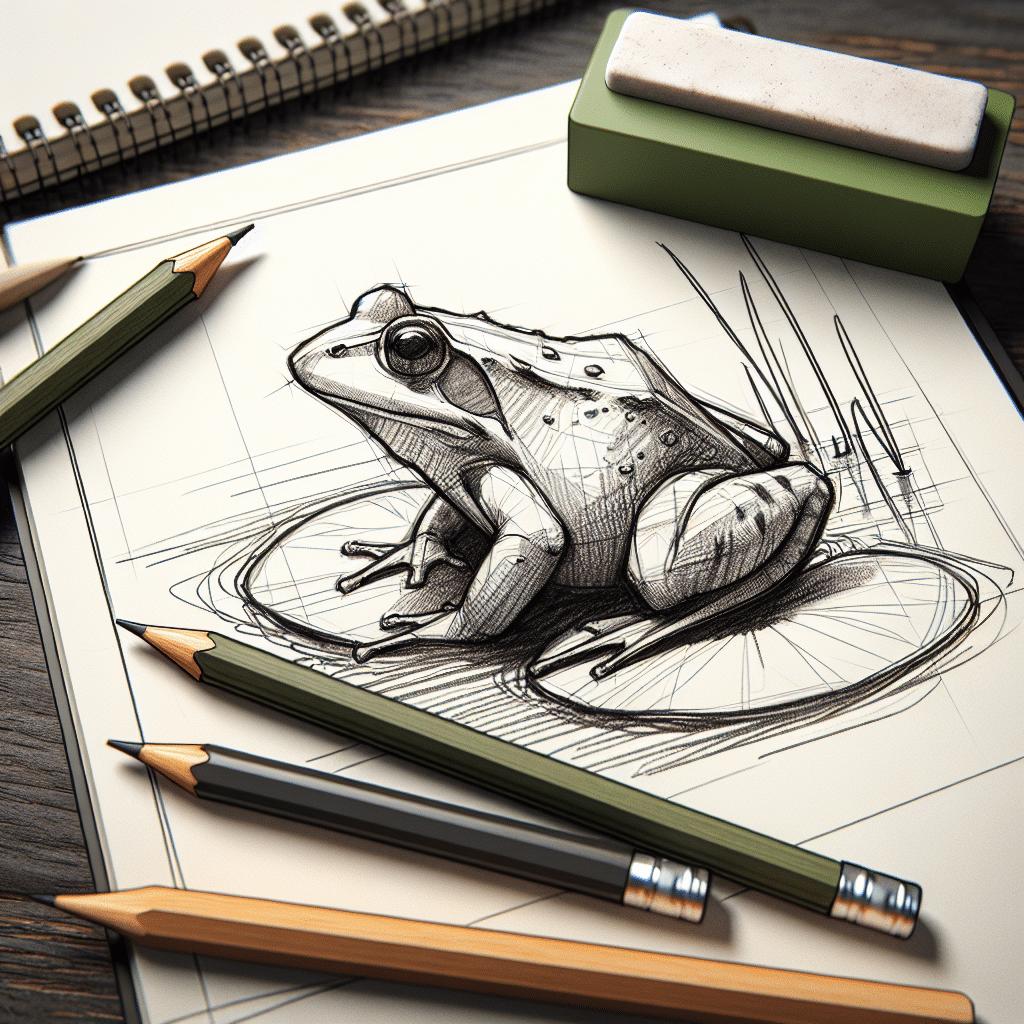Embark on a journey to uncover the lively world of frogs, those fascinating amphibians that have long captured your imagination. From the stillness of a lily pad to the bustling energy of a nighttime chorus, frogs exhibit a spectrum of activity that might just surprise you. In “Are Frogs Active,” you’ll discover the when and why behind their bursts of energy and moments of quiet, painting a full picture of their daily and seasonal rhythms. Whether leaping through your backyard or lying in wait for their next meal, frogs lead lives full of action that reflect the intricate balance of nature’s ecosystems.

Understanding Frog Activity
Defining activity in amphibian terms
When you think about what it means for a frog to be active, you’re looking at a variety of behaviors. Activity in amphibians generally includes moving around in their habitat, hunting for food, escaping predators, breeding, and, for some species, caring for their young. Frog activity can vary widely depending on the species, the time of day, the season, and numerous environmental factors.
Factors influencing frog activity levels
Your slimy friends aren’t randomly hopping about; a multitude of factors influence their activity levels. These include the temperature, humidity, the presence of predators or prey, the need for mating, and the quality of their habitat. Frogs have evolved to be active when conditions are most favorable for survival and reproduction.
Measuring activity: methods and metrics
When you’re trying to gauge how active frogs are, there are several methods and metrics at your disposal. You might tag individual frogs and track their movements using GPS technology or conduct visual surveys to see how often they’re out and about. Metrics used to measure activity might include the distance they move in a given time period, the frequency of their calls during mating season, or the number of times they surface for air if they’re an aquatic species.
Daily Activity Patterns of Frogs
Diurnal vs. nocturnal activity
Just like humans, frogs can be categorized based on when they’re most active. Some frogs are diurnal, meaning they’re up and hopping during the daylight hours. Others are nocturnal and prefer to go about their business under the cover of darkness. This distinction is crucial to their survival, influencing everything from predator avoidance to energy conservation.
Crepuscular behavior in certain frog species
Apart from the diurnal and nocturnal types, you have crepuscular frogs. These are the dusk and dawn aficionados, becoming most active during those twilight hours. This behavior might allow them to enjoy the benefits of both daytime and nighttime activity while avoiding the downsides of each.
Impact of environmental conditions on daily activity
Let’s not forget the whims of Mother Nature. The daily activity of frogs is hugely dependent on environmental conditions like rain, temperature, and humidity. A heavy downpour, for example, could be like a dinner bell to frogs, signaling them to emerge for a night of feeding and frolicking.

Seasonal Activity and Hibernation
Breeding season surges in activity
Come breeding season, you’ll see a positive frenzy of frog activity. This is when frogs are on the move to find mates, stake out the best breeding ponds, and engage in the full-throated cacophony of mating calls. The surge in activity is driven by the need to pass on genes to a new generation.
Hibernation and estivation: Dormancy periods
But frogs aren’t go-go-go all the time. Many species enter periods of dormancy known as hibernation in the winter or estivation during hot, dry spells. During these times, their activity drops dramatically as they conserve energy for more favorable conditions.
Preparation for dormant periods: Feeding and habitat selection
As you’d expect, frogs don’t just dive into dormancy without preparation. They feed voraciously and select the best habitats to hunker down, whether that’s the muddy bottom of a pond or a nice, cool burrow underground. These preparations are essential to their survival during less active periods.
The Role of Temperature and Climate
Temperature dependence of frog metabolism
Here’s a fun fact for you: frogs are ectothermic, which means their body temperature is largely determined by their environment. A frog’s metabolism — and hence its activity level — is directly affected by the ambient temperature. Warmer temperatures might see a flurry of froggy movement, while cooler temperatures slow them down.
Climate change and its effect on frog activity
You’ve undoubtedly heard about climate change, and it’s changing the playing field for frogs around the world. Rising temperatures, altered rainfall patterns, and more extreme weather events can disrupt the activity patterns of these sensitive creatures, leading to potential mismatches in breeding times, foraging opportunities, and predator-prey dynamics.
Adaptations to extreme temperatures
Despite their vulnerability, some frogs have developed amazing adaptations to cope with extreme temperatures. These range from burrowing to conserve moisture and lower their body temperature to changing their behavior to stay out of the heat. It’s a tough world out there, and frogs are doing their best to adapt.

Habitat Impact on Frog Activity
Aquatic vs. terrestrial habitats
Your watery or land-loving frogs will behave differently based on their preferred habitat. Aquatic frogs might spend their active hours swimming and hunting for food in water, while terrestrial frogs are hopping about on land. Their activity is tailored to the advantages and challenges of their specific habitats.
Influence of habitat degradation
Bad news can come in the form of habitat degradation which can wreak havoc on frog activity. Pollution, deforestation, and human encroachment reduce the quality of habitats, leaving frogs with fewer places to feed, mate, and escape from predators. This can lead to decreased activity levels and population declines.
Habitat restoration and increased amphibian activity
But there’s a silver lining: habitat restoration can lead to a resurgence in frog activity. By cleaning up water bodies, replanting forests, and creating protected areas, humans can give frogs a fighting chance to rebound and return to their normal, active selves.
Diet and Foraging Behavior
Feeding cycles and hunting methods
What’s on the menu influences when and how frogs hunt. Some frogs might actively hunt their prey, while others sit and wait for a meal to come by. These varied foraging behaviors and feeding cycles are closely in tune with the availability and type of prey in their environment.
Impact of prey availability on activity
The more food there is, the more active frogs can afford to be. When prey is bountiful, frogs can spend more time foraging and less time conserving energy. This results in higher activity levels, as frogs jump at the chance to fuel up.
Diet variety and activity levels
You are what you eat, and this holds true for frogs too. A diverse diet can improve a frog’s health and energy levels, leading to more activity. However, a lack of dietary variety might mean frogs become less active, as they might not receive the nutrients needed to sustain high levels of energy.
Predator-Prey Dynamics
Evading predators: activity adjustments
Frogs have to constantly balance staying active enough to survive and not so active that they end up as someone else’s snack. They might adjust their activity levels to avoid the times when predators are most active, or use the cover provided by darkness or vegetation to keep a low profile.
Role of camouflage and stillness
Sometimes, the best activity is no activity at all. Frogs will often use camouflage and remain perfectly still to avoid drawing attention to themselves. By blending into their surroundings, they can effectively ‘disappear’ and reduce their risk of predation.
Predation pressure influencing nocturnal activity
Nighttime offers a cloak of invisibility that many frogs utilize. Predation pressure can be a key driver for frogs to evolve nocturnal activity patterns. By being active when their predators can’t see as well, frogs enhance their chances of survival and successful foraging.
Reproductive Activity in Frogs
Mating calls and energy expenditure
When it’s time to get romantic, frogs can be anything but quiet. Males often engage in loud mating calls that can be energetically costly, but it’s a necessary activity to attract females and secure the continuation of their species.
Amplexus and breeding effort
Once a male has successfully serenaded a female, they engage in amplexus, where the male clings to the female to fertilize her eggs as she lays them. The mating process can be a rigorous activity, with males sometimes holding on for hours or even days.
Nesting activity and parental care
While many frogs may leave their eggs to fate, some species take an active role in their offspring’s survival. This can involve anything from building foam nests to guarding the eggs against predators. Such activities are yet another example of how varied frog activity can be.
Movement and Dispersal Patterns
Territorial behavior and home range
Some frogs like to stake a claim and stick to it. They establish territories and home ranges that they actively patrol and defend against others of their kind. This territorial behavior can result in some lively confrontations and a lot of hopping around.
Migration patterns in certain species
Believe it or not, some frogs have a migratory streak. When the seasons change or breeding time comes, they may undertake long journeys to reach optimal habitats for feeding or laying their eggs. These migrations can be impressive feats of activity and endurance.
Dispersal of juveniles from breeding grounds
After tadpoles transition into adulthood, it’s time for them to strike out on their own. The dispersal from breeding grounds to new habitats is a critical period of activity where young frogs must navigate the perils of the world to establish their own territories.
The Future of Frog Activity Research
Emerging technologies and methodologies
The future is bright for understanding frog activity, with emerging technologies and methodologies coming into play. Imagine tiny tracking devices or advanced environmental monitoring systems that provide unprecedented insights into the secret lives of these amphibians.
The importance of long-term monitoring programs
You’ll find that long-term monitoring programs are indispensable. They offer a treasure trove of data that can highlight trends, reveal the impacts of environmental changes, and inform conservation strategies. Staying the course with these programs is vital for protecting frog populations.
Predicting and mitigating the impacts of global change on frog activity
Armed with the knowledge from ongoing research and long-term data, humans can strive to predict and mitigate the impacts of global change on frog activity. From altering conservation priorities to crafting environmental policies, every bit of information empowers us to make better decisions for the frogs and the ecosystems they inhabit. Remember, these little hoppers play a crucial role in the health of our planet, and understanding their activity is key to ensuring their survival.



